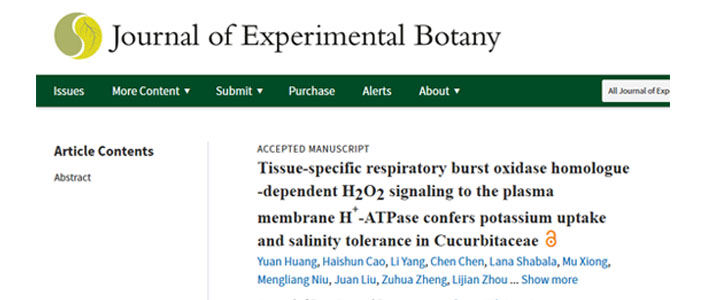v

BioArt植物:JXB | 华中农业大学别之龙团队揭示南瓜和黄瓜耐盐性差异的分子机制
期刊:Journal of Experimental Botany
主题:南瓜和黄瓜耐盐性差异的分子机制
标题:Tissue-specific respiratory burst oxidase homologue -dependent H2O2 signaling to the plasma membrane H+-ATPase confers potassium uptake and salinity tolerance in Cucurbitaceae
影响因子:5.360
检测指标: K+流速
检测部位:距离根尖1mm
K+流实验处理方法:
5日龄黄瓜幼苗,75mM NaCl处理24小时
K+流实验测试液成分:
0.5mM KCl,0.1mM CaCl2,pH 5.7
作者:华中农业大学别之龙、黄远
英文摘要
Potassium (K+) is a critical determinant ofsalinity tolerance, and H2O2 has been recognised as an important signalingmolecule that mediates many physiological responses. However, the details onhow H2O2 signaling regulates potassium uptake in the root under salt stressremain elusive. In this study, the salt sensitive cucumber and salt tolerantpumpkin which belong to the same family cucurbitaceae were used to answer theabove question.
Weshow that higher salt tolerance in pumpkin was related to its superior abilityfor K+ uptake and higher H2O2 accumulation in the root apex. Transcriptomeanalysis showed that salinity induced 5886 (3005 up and 2811 down) and 4679(3965 up and 714 down) differentially expressed genes (DEGs) in cucumber andpumpkin, respectively. DEGs encoding NADPH oxidase (RBOHD), 14-3-3 protein(GRF12), plasma membrane H+- ATPase (AHA1) and potassium transporter (HAK5)showed higher expression in pumpkin than cucumber under salinity stress.Treatment with a NADPH oxidase inhibitor diphenylene iodonium resulted in alower RBOHD, GRF12, AHA1 and HAK5 expression, reduced plasma membrane H+-ATPase activity, and smaller K+ uptake, resulting in a loss of salinitytolerance trait in pumpkin. The opposite results were obtained when the plantswere pre-treated with exogenous H2O2. Knocking out of RBOHD in pumpkin byCRISPR-Cas9 editing of coding sequences resulted in lower root apex H2O2 and K+content and GRF12, AHA1 and HAK5 expression, ultimately resulting in asalt-sensitive phenotype. However, ectopic expression of pumpkin RBOHD inArabidopsis led to the opposite effect.
Taken together, this study shows that RBOHD-dependent H2O2 signaling in the root apex is important for the pumpkin salttolerance and suggests a novel mechanism that confers this trait, namelyRBOHD-mediated transcriptional and post-translational activation of plasmamembrane H+-ATPase operating upstream of HAK5 K+ uptake transporters.
中文摘要(谷歌机翻)
钾(K+)是耐盐性的关键决定因素,H2O2已被认为是介导许多生理反应的重要信号分子。然而,关于H2O2信号如何在盐胁迫下调节根中钾吸收的细节仍然难以捉摸。在这项研究中,使用属于同一科葫芦科的盐敏感黄瓜和耐盐南瓜来回答上述问题。
我们表明,南瓜中较高的耐盐性与其对根尖的K +吸收能力和较高的H2O2积累有关。转录组分析显示盐度分别诱导黄瓜和南瓜中5886(3005上和下2811下)和4679(3965上和下714)差异表达基因(DEG)。在盐胁迫下,编码NADPH氧化酶(RBOHD),14-3-3蛋白(GRF12),质膜H+- ATP酶(AHA1)和钾转运蛋白(HAK5)的DEGs在南瓜中的表达高于黄瓜。用NADPH氧化酶抑制剂二亚苯基碘处理导致较低的RBOHD,GRF12,AHA1和HAK5表达,降低的质膜H+- ATP酶活性和较小的K+摄取,导致南瓜中盐度耐受性状的丧失。当用外源H2O2预处理植物时获得相反的结果。通过编码序列的CRISPR-Cas9编辑敲除南瓜中的RBOHD导致较低的根尖H2O2和K+含量以及GRF12,AHA1和HAK5表达,最终导致盐敏感表型。然而,拟南芥中南瓜RBOHD的异位表达导致相反的效果。
总之,本研究表明,根尖中依赖RBOHD的H2O2信号传导对南瓜耐盐性具有重要意义,并提示了一种赋予这种特性的新机制,即RBOHD介导的质膜H+-ATPase的转录和翻译后激活。 HAK5 K+摄取转运蛋白的上游。

Figure 7. Relative expression of GRF (14-3-3 protein), AHA (plasma membrane H+-ATPase) and HAK5 (high affinity K+ transporter) in the root apex of cucumber (A, C, E) and pumpkin (B, D, F) exposed to 75 mM NaCl for 24 h. (G) to (J): plasma membrane H+-ATPase activity and net K+ flux measured after 24 h of exposure to 75 mM NaCl stress from the root apex pre-treated for 1 h in solutions containing specific chemicals (DPI, an NADPH oxidase inhibitor, H2O2) in cucumber (G, I) and pumpkin (H, J). Values are the mean ± SE (n=4). Different letters indicate significant difference (P < 0.05) according to Duncan's multiple range tests. The gene ID for cucumber GRF, AHA and HAK5 is Csa3G890040 (GRF8), Csa1G045600 (AHA11) and Csa3G835810 (HAK5), and it is CmoCh01G016540 (GRF12), CmoCh11G003690 (AHA1) and CmoCh08G004000 (HAK5) for pumpkin.
文章链接:
https://academic.oup.com/jxb/advance-article/doi/10.1093/jxb/erz328/5530665
旭月版权所有,转载注明出处
